by Delton P.

Quick Look:
Shasn is a political strategy game where you build your political platform as you play. It's surprisingly realistic, touching on many of the hot-button issues of today in a way that is true to the political process. Sometimes you have to compromise your values to get votes, but sticking to your guns will help you rise in power within your constituency. The base mechanics are set collection, area control, and negotiation, but there are a lot of other things going on including conspiracies, gerrymandering, and blackmail. It doesn't bash any particular ideological approach, but it points out some weaknesses in a way that's poignant and frequently humorous.
Designer:Zain Memon
Artist:Soumik Lahiri
Publisher:Memesys Culture Lab
Year Published: 2019
No. of Players: 4-5
Ages: 12+
Playing Time: 90-120 min
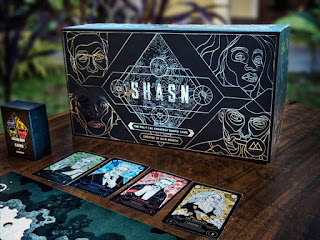
WARNING: This is a preview of Shasn. All components and rules are prototype and subject to change.
Review: Shasn
Rules and Setup:
Setup is speedy. Everyone gets a bag of pegs in their color, one of each resource, and a player board. Put the main and secondary board on the table. Shuffle the various decks and put them on their labeled spots on the secondary board. That's it.
The First Turn Rule is now this: At the start of the game, each player votes for an opponent to be the first player. You cannot vote for yourself. The first player gets one resource of their choice, the second gets two, the third gets three and the fourth gets four resources.
The rules are very clear and easy to explain. If you know the game well, you can teach it in about ten minutes.
Fast-forward a bit, and it looks like this:
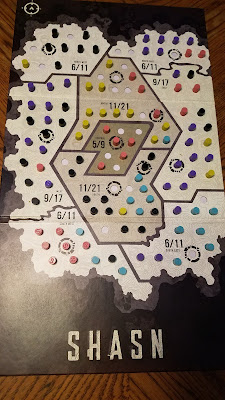
The secondary board:

Theme and Mechanics:
This is politics, so your main goal is to gain enough voters to have the majority in a district. You do this by spending resources to obtain voters. Vote cards have a big number that tells you how many pegs you can put on the board in one district, and symbols that tell you what resources you have to spend to do so.

When you buy Voters, you place pegs into whatever region you like. You can buy as many cards as you can afford, but Voters on one card can't be split among different regions.
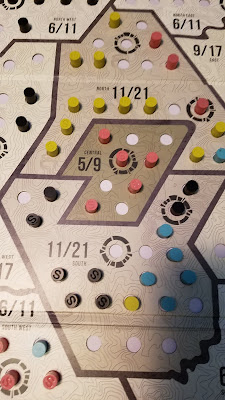
Each region has two numbers on it. The left number is how many voters are required for a majority. The right number is how many Voters total can be placed on that region. Once all the holes are full, no more Voters can be placed there. Each region only scores for the player who has the majority, and only as many points as are needed for the majority. For example, having four pegs in that darkest region (5/9) scores nothing. Five is the number necessary for a majority, so five or more would net you five points. Generally, you don't want more pegs in a region than are required for the majority, but there are a lot of powers that affect Voters. You might want a few extra.
Pegs have an S on one side. Voters are always placed blank side up until a majority is reached. Once a player has a majority, they flip a number of voters in that region to their S side equal to the majority condition. Each S-peg gets you one point at the end of the game. If something causes you to lose the majority, you flip them all back over. Most effects can only target non-majority voters. The ones that do say so.
If you place a peg in a Volatile Region (the ones with the black ring around them), they can't be moved by any effect. At the end of a turn that a peg is placed in a Volatile Region, the player that Voter belongs to draws a Headline card. These are events that can be beneficial or disastrous. The first one we drew killed the Voter.

This is a platform well into the game.
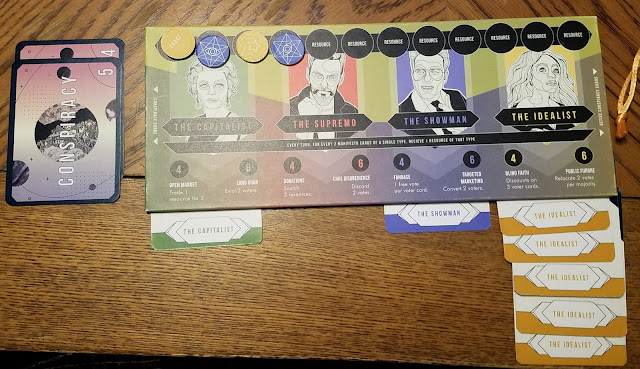
The theme is incredibly well done. You have four archetypical approaches to policy: the Showman, the Capitalist, the Supremo, and the Idealist. Each turn starts with the previous player reading a question in an Idealogue card. The Cards have a different answer on each side that corresponds to one of the 4 archetypes. You will get different resources depending on your answer and then slide that card into your platform with just the archetype showing. You aren't allowed to know the resources or the card type before you answer, but they are generally easy to figure out. Choosing is sometimes difficult because you will want to answer using your actual philosophy, but that's not always going to work out. Having more than 6 of a card type doesn't unlock any more powers. Sometimes your answer might make you throw up a little bit when you say it. But, that's politics. You can't do any good if you don't get elected. If you want to win, you have to compromise, lie, backstab, cheat, and occasionally murder.
Every two cards of the same type will get you one corresponding resource each turn. Also, four and six cards of the same type unlock powerful special abilities. As the game progresses, you will have more and more options on your turn. It's all very thematic. The Idealists are the nicest, so their 6 power is to move more voters around when gerrymandering. The Supremo is the meanest. They kill voters, but they have to pay resources to do so.
I love how the resources are divided among the different answers. Each answer reflects a combination of two archetypes. The funny answers usually provide media (Showman), the big evil government answers give you clout (Supremo), the nice PC stuff provides trust (Idealist), and the greedy cards provide funds (Capitalist). So if you have a card that asks if you should ship all the homeless out of the cities and the answers are "Yes, out of sight out of mind" or "No. We should give them tiny futuristic houses to wheel around in," you can guess which resources you'll get with each answer and what the card type will be. Sometimes it will surprise you, but it generally makes sense when you think about it.
Here are a few examples.
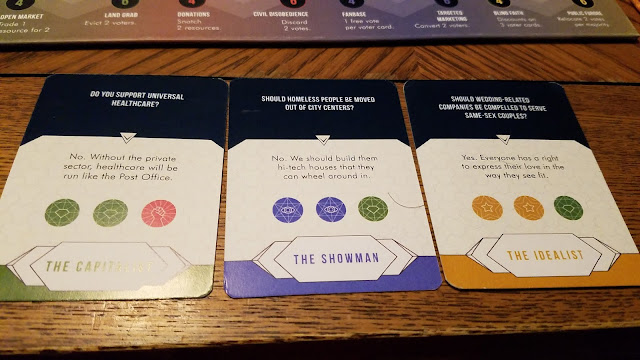

Another power you will unlock is Gerrymandering. If you're not familiar with that term, that's what politicians call the act of redrawing voting districts against the will of the people. The number of voters for each candidate doesn't matter as much as where they live. If you draw the lines so that the majority of Democrats are concentrated in one district with just a few scattered around those surrounding it, the Republicans can ensure that they get the majorities needed to win more district.That's why we need a 3-party system.
In the game, Gerrymandering is moving Voter pegs to a neighboring district. For each district you have a majority in, you can move one non-majority peg of any player to an adjacent district. You can't move any peg from/to anywhere, but if your majorities are spread out, you have a lot of options. This is a way to slow down opponents and even force pegs into Volatile Regions.
Then we have Conspiracies.
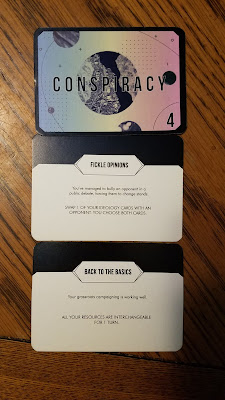
Pay the cost on the back of the Conspiracy using any combination of resources. That top one would cost 4, some cost 5. You never know what the conspiracy will be until you buy it. The two shown above are just examples. Some are better than others.
Finally, you can Form Coalitions. Two players can team up to form a majority. This gives them a point for each of the pegs they flip and the ability to Gerrymander. Coalitions can be dissolved at any time by any player involved. You can negotiate and exchange resources or cards at a rate of one to one.
Its serious strategic base is complimented with enough humor to make it fun for all players, even when playing with a mixed political group. Too many political games these days are targeting people of one specific ideology. It's refreshing to see political humor approached with maturity.
The game ends when a player gains a majority in the last open district. At that point, count up the votes. Each district is worth points equal to its majority value. Whoever has the most points gets to run the new world order.
Game Play:
On your turn, you can do as many actions as you can afford and have unlocked. In the beginning, you'll just be answering your question, getting resources, and buying voters. By the end, you'll be buying multiple cards, playing conspiracies, forming coalitions, and Gerrymandering Voters all over the place. Even with all that, rounds go fast. Shasn has a very nice flow. It's straightforward enough to prevent AP, but you get to do a lot of different, easy things on your turn.
Artwork and Components:
This is a prototype, but when I opened it I was legitimately dazzled.
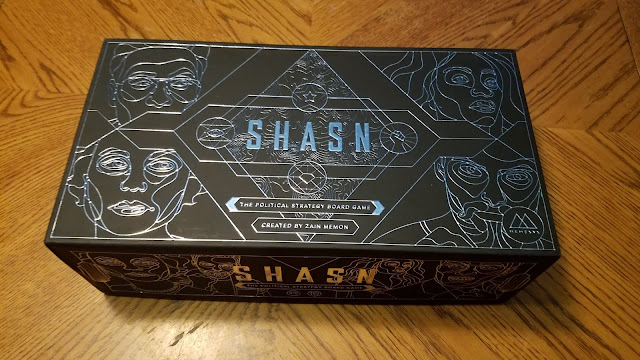
It's a huge box covered in raised, shiny silver. It came with lovely magnetic keep boxes for the Idealogue cards and tokens plus decent drawstring bags for pegs. The creators made it a point to mention that the components would be improved upon in the final product, but this is already pretty nice.
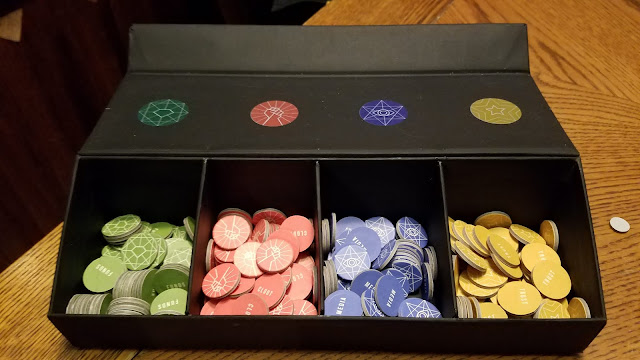
Why don't more games come with these things?
The Good:
It's fun and ingenuitive.
Fast to set up and learn.
Great component design.
There are four sets of cards. One American politics, another is Indian, then we have Rome, and the future. This is actually an Indian game with an American version, but you'd never know from playing it. They nailed American politics better than any other game I can think of.
Quick turns.
This might help you to understand your own politics better, as well as the political process.
Looks beautiful on the shelf.
Player count from 3-6 makes it easy to get on the table.
The Other
It's a shelf hog, but it's too pretty for that to be a complaint.
Final Thoughts:
Shasn is the best thing to come out of American politics in a very long time. I wanted to review this because it sounded a lot like Twilight struggle for more players. This isn't as intense, but it's a lot more fun, IMO. If there's any chance you might like a medium weight game with a political theme, give Shasn your full attention.
For Players Who Like:
Politics, strategy games, engine building, set collection, mature humor of the non-CAH variety, area control.




